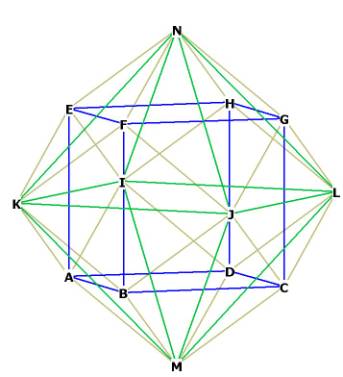|
(2017
midterm assignment) Model Student Midterm answers 2017 (Index) Essay 1: Compare, contrast, and evaluate Narratives of the Future |
 |
Anari
Oliver
November 6th-8th, 2017
The Three Narratives in a Nutshell
Literature of the Future has been by far the most intriguing class that I
have experienced throughout my college career. In this time, I have gained more
knowledge about Sci-Fi movies/novels than I ever intended. On the same note,
I’ve also been granted the opportunity to gain an appreciation for those who
have laid the foundation for this subject. Creation/apocalypse, evolution, and
alternative-future narratives have opened my eyes by allowing me to see things
from different perspectives.
The
creation/apocalyptic narrative presents us with a linear timeline that is much
easier to comprehend. These particular narratives can be broken in three
different spans: creation, expulsion, and an apocalypse (with the hope of new
life and opportunity). This linear layout usually encompasses a biological life
cycle where we see a rise or emergence, a blooming or some sort, and then an
extreme downfall. Marion Johnson states “The creation/apocalypse narrative has
ancient roots, and can be seen in texts such as the bible.” Genesis, the first
book of the bible, embodies the perfect example of creation and expulsion of
this type of narrative. Creationism is exhibited through God’s labor where he
created the Earth and its belongings (including Adam and Eve) in 6 days. They
are created in his image until they go against his word by committing the sin of
eating the forbidden fruit from the tree of knowledge. Once exiled, the couple
has to endure many hardships as punishment. Apocalypse or “Millennialism”, on
the other hand, is the belief in an end-time or transformation of the world.
Revelation, the final book of the bible, portrays Christ as a hero who will
defeat evilness, and lead his followers to a new life. Parable of the Sower by
Octavia Butler is one of our main stories that follow this creation/apocalyptic
narrative.
Lauren Olamina is the protagonist who lives in a walled community away
from the world’s destruction and corruption. Her neighborhood acts as a utopia
in comparison to the outside similarly to the Garden of Eden in Genesis. She
goes on to lose her brother, Keith, her father goes missing, and eventually the
remainder of her family is killed during a fire. Olamina is then forced out of
her “safe haven” where she must sacrifice her life in order to rebirth her own
utopia. In comparison to Revelation, Parable undergoes an environmental
apocalypse since havoc engulfs the geography, and resources such as food and
water are miniscule. As Parable progresses it eventually slips into our second
narrative known as evolution.
Evolution can mean many different things, but its most basic meaning
involves continuity, plus change where we begin to see in Lauren’s life
firsthand. Olamina and her crew are survivors of what used to be and must learn
to survive in the “dog-eat-dog” world that surrounds them. She creates her own
philosophy, which opposed her father’s Baptist teaching called Earthseed. This
becomes her driving force and guide of the new community that she begins to
build during her journey. Throughout the novel, Lauren prophesizes about
Earthseed’s key principles. God is change being the first, secondly, humans must
adapt to the changing world around them for survival; thirdly, change is the
greatest constant in life. In so many words, Earthseed basically states “in
order to survive, one must become harmonious with change.” This type of
statement goes hand in hand with Darwin’s “survival of the fittest” theory.
Stone Lives by Paul Di Filippo wholeheartedly places us under the
evolution narrative. The “dog-eat-dog” or “survival of the fittest” theory is
always a primary key in any evolutionary story. Stone, a blind man from a
primitive and dysfunctional society, known as the Bungle, is the main character
of the story. Filippo shows Stone evolving from the start to the finish of
story. We often see a particular character become the “chosen” one in
evolutionary narratives, which Stone was after being selected by a cyborg named
Alice Citrine. Stone receives a set of artificial eyes that allow him to record
the world around him, play it back at his convenience, and upload to a computer
system. With his new senses, he’s able to assert dominance throughout the
competitive environment that he has been shoved into. The final stage of
evolution takes place at the end of the story when the company is attacked by
assassins. This attack disabled the electronics in the building, including
Stone’s artificial eyes. His old street-smart instincts from the bungle kick in,
in order to kill the assassin who was looking for him. Stone is then left blind
again without his implants and must succeed the throne of Citrine.
Another story that falls under the evolutionary umbrella is Bears
Discover Fire by Terry Bisson. Unlike Stone Lives, Bears provides a setting that
is a bit more homelike and warm that is somewhat relatable (being that a country
setting brings comfort to many people as opposed to a poor man descending from a
cyborg). In this story, bears have now learned to operate and use fire to their
advantage. This shows that their existence has developed tremendously, and now
they no longer hibernate contrary to what bears are known to do during winter.
Historically, fire has always been a symbol of human advancement being that it
provides us with both heat and light. Whether we want to admit it or not, the
characters in the story had to evolve and adapt to this bizarre and unfamiliar
situation. Because humans have evolved so much since the beginning of time;
evolution in a sense has made human beings a bit arrogant. The idea that
something “subhuman” being able to decently maneuver fire comes as a hard pill
for humans to swallow.
Our last narrative of the three is the odd man out, and commonly referred
to as alternative-future. This particular narrative can be a real mind-boggler
because it pertains to quantum physics and time travel capabilities that the
average person lacks basic knowledge of. In comparison to the linear
creation-apocalypse narrative and evolutionary narratives, alternative-future
narrative may seem out of the ordinary or exotic to most readers, but can
provide the reader with new possibilities, insight, and unique perspectives on
nature and reality.
Alternative future narratives have a tendency to provide its readers with
foresight and decision-making options that may help them pick certain paths and
possibilities to get to where they want to be. The story that embodies this
narrative is titled Better Be Ready ‘Bout Half Past Eight in which gender
fluidity is touched on. This story automatically fits under the alternative brim
because Zach is beginning to experience what his life would be like as a woman.
He begins to undergo changes that would ultimately alter his gender. Throughout
the storyline, Zach expresses that he has finally found his own truth, which is
the opposite of how he was born. Not only did Zach face obstacles due to his
inner truth, Byron, his best friend did as well as a result of Zach’s big news.
Byron then begins to experiment with his own sexual identity. Once Zach
transforms into his new self, Byron also deals with a sexual orientation crisis
that came along with self-doubt. Towards the end, we see Zach become content
with a new lifestyle, while Byron pass less attention to his sexual identity,
and shifts his focus on supporting Zach (now Zoe)’s new prescribed identity.
In a sense, both characters fulfill two different realities for the same
“obstacle” or crisis. Eventually both Byron and Zach become comfortable with
themselves for who they truly are, by picking their own paths of dealing with
the truth. The idea of a new found truth shapes the theme for alternative-future
narratives, and two separate timelines were created by showing us what the
outcome could be in both cases.
Lastly, The Time Machine by H.G. Wells resembles several future
narratives that incorporate all three that we’ve learned. It starts out as s
time travel story with a loony timeline. The narrator, also known as the Time
Traveler, talks about an ambiguous future that could be authentic but comes with
a side of doubt. When you actually analyze the story, you realize that because
the idea of time travel and quantum physics is a bit exotic, readers are almost
forced to trust the Time Traveler’s words. The ambiguity of what the future may
bring and the notion of time travel illustrates the alternative-future
narratives. The evolution narrative is represented through both the Morlocks and
the Elois. “By the year AD 802,701, humanity has evolved into two separate
species, whereof the Eloi live a banal life of ease on the surface of the earth,
while the Morlocks live underground, tending machinery and providing food,
clothing, and inventory for the Eloi.” The excerpt from the story itself gives
background to the two different species, and also makes a distinction between
classes or status. The Elois were the elite or upper class, while the Morlocks
were the working class group. That idea of the Darwin’s “survival of the
fittest” theory seen in both Stone Lives and Parable is also represented in Time
Machine by giving us the evolution of new species. The rich turn into poor
imbeciles while the poor species turned into subsurface cannibals. As far as the
creation-apocalypse narrative is concerned, the notion that end times are coming
presented by a direct timeline solidifies this particular narrative.
In the end, all three narratives mesh together in a nutshell. Each story
exemplifies the narratives by highlighting qualities that each narrative is
known to possess. I’ve gained an appreciation for science fiction as a whole. In
the future, I can’t wait to see what else this exotic chapter holds for me.
 |
 |
 |
